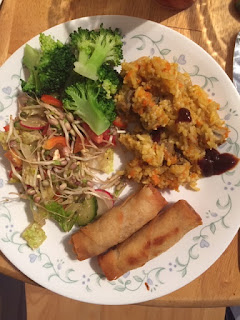The four food groups have come to an inglorious end.
Everything I’ve known to be true about healthy eating was thrown out the window on Tuesday with the unveiling of Canada’s new food guide.
There is no more dairy group. Forget it ever existed. (This is not a plot to destroy the Canadian dairy industry...)
Dairy and meats, low-fat and lean, are now just one of many in the “protein foods” category. Like it or not, they now share the spotlight with beans and all the other “meat alternatives.”
Remember learning about the alternatives? They sounded like an after-thought following a big helping of red meat. Perhaps some salted almonds after your meal? It’s all good, so long as you eat your meat. And drink your milk. Two glasses a day!
It was only last year that my daughter, after becoming educated using the old food guide, started lecturing me on how many servings of grains I needed to eat every day.
“But how much is a serving?” I asked her.
She held out her hand, showing me visually that this is a serving – basically, whatever can fit in an 11-year-old's palm.
The old food guide, which has not changed substantially since my birth year of 1977, told us how many servings we needed of everything. It was corrupted, we now learn, by the lobbying of various industries (ahem, beef and dairy), but you didn’t have to use much imagination to follow it.
You needed 6-8 servings (i.e. handfuls) of grains a day, which could take the form of anything from cereal to bagels. Even my child knows a bagel has next to no nutritional value; we eat them because they taste good, particularly with cream cheese, which may have also qualified as a serving of dairy.
The new food guide is much less prescriptive, which I applaud. It tries to keep things simple – half fruits and vegetables, and then the rest, namely protein foods and grains. Stay away from the processed foods, stick to whole grains when it comes to carbs, and don't overdo it on the fats (no, bacon is not a substitute for bagels).
 |
| The new food guide: A plate of healthy wonder |
The new guide encourages more plant-based foods in place of meat, which I think is shooting for the stars when it comes to the average (above average when it comes to weight) Canadian, but at least it’s speaking the truth. You can’t knock vegetables for nutritional value.
It even broaches the topic of alcohol. Contrary to popular belief, wine is not a fruit! It’s not even good for you anymore. Alcohol makes you fat and drinking too much increases your risk of cancer.
Even 100% real fruit juice is not a fruit. It’s a sugar-drink that contributes to dental decay, obesity and type-2 diabetes. Yikes! Hide the apple juice!
Instead, drink plain old water. Who would’ve thought it could be so good for you?
If only we knew about this when I was young. Growing up, it was corn flakes and orange juice for breakfast, melt-in-your-mouth white-breaded peanut butter and jam sandwiches for lunch, then meat and potatoes for supper with corn on the side. What's so bad about that? As it turns out, um... almost everything? It wasn't our fault though – we were deceived.
The changes to the food guide were needed and long overdue. They're based on solid evidence and research that have existed for quite some time.
